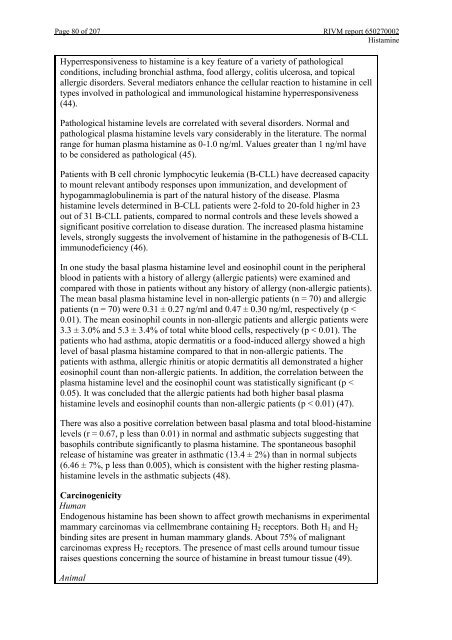The Contribution of cocoa additive to cigarette smoking addiction
The Contribution of cocoa additive to cigarette smoking addiction
The Contribution of cocoa additive to cigarette smoking addiction
You also want an ePaper? Increase the reach of your titles
YUMPU automatically turns print PDFs into web optimized ePapers that Google loves.
Page 80 <strong>of</strong> 207 RIVM report 650270002<br />
Histamine<br />
Hyperresponsiveness <strong>to</strong> histamine is a key feature <strong>of</strong> a variety <strong>of</strong> pathological<br />
conditions, including bronchial asthma, food allergy, colitis ulcerosa, and <strong>to</strong>pical<br />
allergic disorders. Several media<strong>to</strong>rs enhance the cellular reaction <strong>to</strong> histamine in cell<br />
types involved in pathological and immunological histamine hyperresponsiveness<br />
(44).<br />
Pathological histamine levels are correlated with several disorders. Normal and<br />
pathological plasma histamine levels vary considerably in the literature. <strong>The</strong> normal<br />
range for human plasma histamine as 0-1.0 ng/ml. Values greater than 1 ng/ml have<br />
<strong>to</strong> be considered as pathological (45).<br />
Patients with B cell chronic lymphocytic leukemia (B-CLL) have decreased capacity<br />
<strong>to</strong> mount relevant antibody responses upon immunization, and development <strong>of</strong><br />
hypogammaglobulinemia is part <strong>of</strong> the natural his<strong>to</strong>ry <strong>of</strong> the disease. Plasma<br />
histamine levels determined in B-CLL patients were 2-fold <strong>to</strong> 20-fold higher in 23<br />
out <strong>of</strong> 31 B-CLL patients, compared <strong>to</strong> normal controls and these levels showed a<br />
significant positive correlation <strong>to</strong> disease duration. <strong>The</strong> increased plasma histamine<br />
levels, strongly suggests the involvement <strong>of</strong> histamine in the pathogenesis <strong>of</strong> B-CLL<br />
immunodeficiency (46).<br />
In one study the basal plasma histamine level and eosinophil count in the peripheral<br />
blood in patients with a his<strong>to</strong>ry <strong>of</strong> allergy (allergic patients) were examined and<br />
compared with those in patients without any his<strong>to</strong>ry <strong>of</strong> allergy (non-allergic patients).<br />
<strong>The</strong> mean basal plasma histamine level in non-allergic patients (n = 70) and allergic<br />
patients (n = 70) were 0.31 ± 0.27 ng/ml and 0.47 ± 0.30 ng/ml, respectively (p <<br />
0.01). <strong>The</strong> mean eosinophil counts in non-allergic patients and allergic patients were<br />
3.3 ± 3.0% and 5.3 ± 3.4% <strong>of</strong> <strong>to</strong>tal white blood cells, respectively (p < 0.01). <strong>The</strong><br />
patients who had asthma, a<strong>to</strong>pic dermatitis or a food-induced allergy showed a high<br />
level <strong>of</strong> basal plasma histamine compared <strong>to</strong> that in non-allergic patients. <strong>The</strong><br />
patients with asthma, allergic rhinitis or a<strong>to</strong>pic dermatitis all demonstrated a higher<br />
eosinophil count than non-allergic patients. In addition, the correlation between the<br />
plasma histamine level and the eosinophil count was statistically significant (p <<br />
0.05). It was concluded that the allergic patients had both higher basal plasma<br />
histamine levels and eosinophil counts than non-allergic patients (p < 0.01) (47).<br />
<strong>The</strong>re was also a positive correlation between basal plasma and <strong>to</strong>tal blood-histamine<br />
levels (r = 0.67, p less than 0.01) in normal and asthmatic subjects suggesting that<br />
basophils contribute significantly <strong>to</strong> plasma histamine. <strong>The</strong> spontaneous basophil<br />
release <strong>of</strong> histamine was greater in asthmatic (13.4 ± 2%) than in normal subjects<br />
(6.46 ± 7%, p less than 0.005), which is consistent with the higher resting plasmahistamine<br />
levels in the asthmatic subjects (48).<br />
Carcinogenicity<br />
Human<br />
Endogenous histamine has been shown <strong>to</strong> affect growth mechanisms in experimental<br />
mammary carcinomas via cellmembrane containing H2 recep<strong>to</strong>rs. Both H1 and H2<br />
binding sites are present in human mammary glands. About 75% <strong>of</strong> malignant<br />
carcinomas express H2 recep<strong>to</strong>rs. <strong>The</strong> presence <strong>of</strong> mast cells around tumour tissue<br />
raises questions concerning the source <strong>of</strong> histamine in breast tumour tissue (49).<br />
Animal
















